Wetpixel asks the Pros: Wide-angle 1
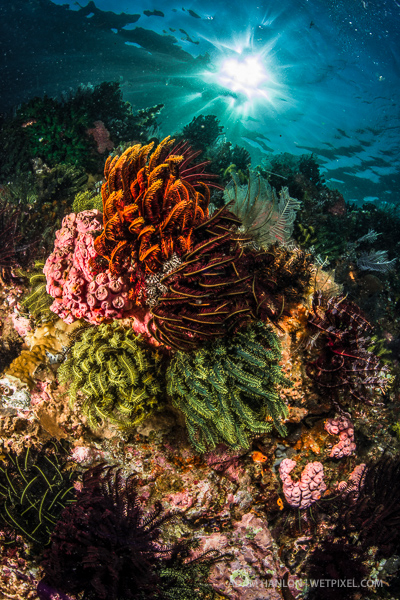
Cristian Dimitrius
Cristian Dimitrius is a Brazilian Emmy Award Winning cinematographer, photographer, biologist and television presenter specializing in wildlife and natural history films around the world.
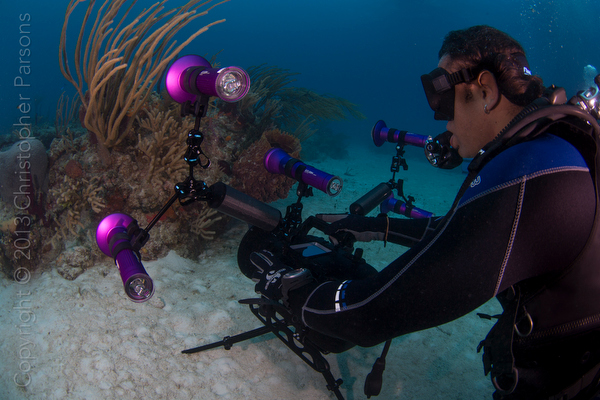
What is you favorite wide-angle lens (please also specify with which camera-more than one answer is allowed :))?
I love the 16-35mm in either my 5D Mk III for stills or in my RED Dragon. I recently tried the 11-24, the widest rectilinear WA lens available and liked it very much, specially for videos where there is no distortion at all.
Do you prefer the look of fisheye or rectilinear wide-angle?
It depends, I really like some still fish-eye shots but not so much on videos. I used some fish-eye lens in video for some static situations, scenic, but most of the time when doing video I go rectilinear.
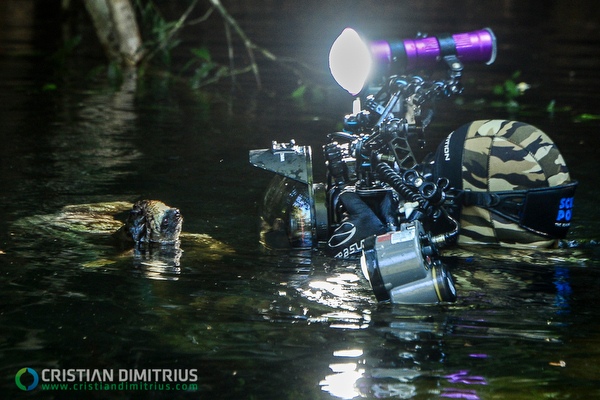
How do you light wide-angle images or video? What metering pattern do you use? TTL or manual strobe control?
I always try natural light First. For wide-angle video it is always my first choice but I also use 2 Keldan video lights that have a very good quality light, 10k lumen and a smooth wide beam. My arms are usually spread out to cover a large area or out of the camera, or water, pretending to be the sun light. All the metering is manual, even when I am using strobes for stills.
Do you “expose to the right”? Does this technique work/apply for video shooters?
I don’t. I try to “expose to the center” whenever is possible, and sometimes even to the left (when shooting silhouettes, sun balls, poetic backlights).
In video an overexposed pixel is lost and cannot be recovered. A dark area could be kind of recovered, depending the camera you are using, and also the ISO, because if there is a lot of post-processing you seriously increase noise in your image.
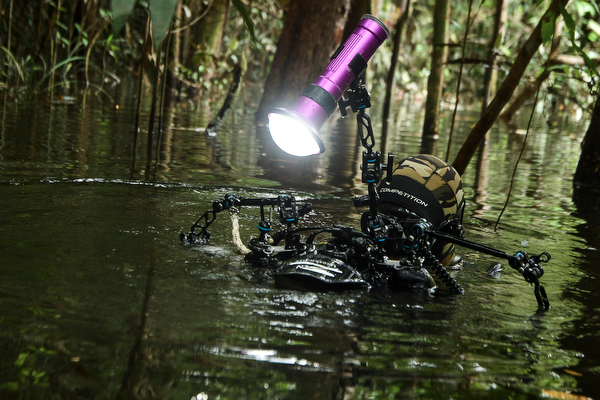
The best always, in my point of view, when talking about UW video, is get it “right”, meaning “expose to the center”, when you shoot! This will give you a good range to work on post, specially if shooting raw video.
What are your “go-to” wide-angle exposure settings? How is your camera set up when you get off the boat?
On my Red camera ISO 320, Shutter 180º, Aperture f.4. But i usually dive in dark, extreme waters. In the Caribbean-like waters I begin with f.8. My ISO and shutter in my video camera is usually fixed so my exposure method consists only in adjusting Iris and ND filters.
When shooting large animals in the blue (green) do you worry about corner sharpness?
I do, specially when the subject is very close and I am doing stills.
Under what situations would you use shutter priority or aperture priority wile shooting wide angle?
Never when doing videos underwater. Maybe, in some stills situations with a tricky lightning I could go to shutter priority as reference, but I always ended up going back to manual.
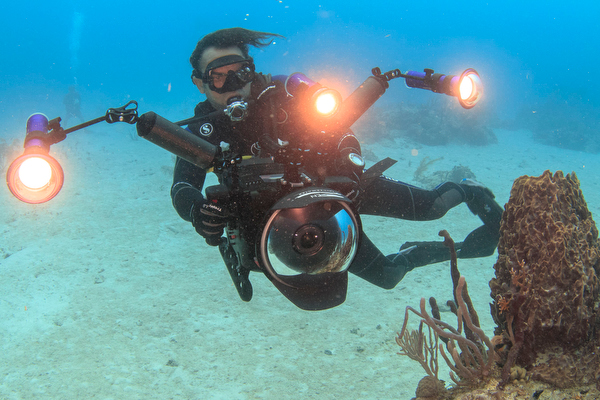
David Salvatori
Diving for passion since 2007, with the greatest aspiration to raise awareness of our endangered nature. His website.
What is you favorite wide-angle lens:
Sigma 15mm fish-eye lens, but I am looking for a RS 13mm fish-eye lens in good conditions :-) My camera is Nikon D800E
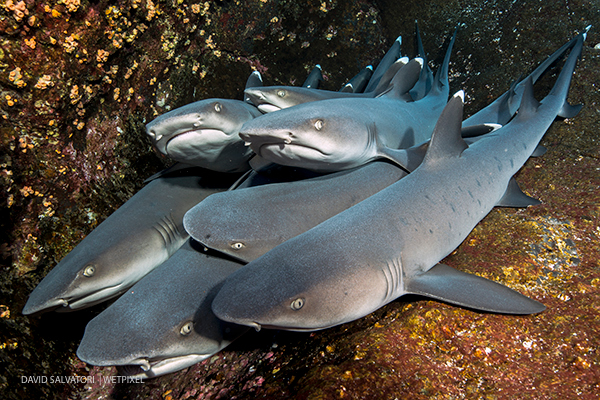
Do you prefer the look of fisheye or rectilinear wide-angle?
Fisheye, I usually use rectilinear wide-angle (Nikon 16-35) for medium-sized animals (sharks). When playing with my mini-dome to get close-focus-wide-angle I even go with Tokina 10-17mm, it’s very versatile, I got it when I had my Nikon D300 and I still use it with my D800E, I have a 1,5x cropping factor but I am not suffering too much sacrificing a bit of my full frame…
How do you light wide-angle images or video? What metering pattern do you use? TTL or manual strobe control?
I have 2 Seacam 150D strobes, 90% of times I go manual because I want full control of the foreground exposure…the only situation where I can choose to go TTL is when dealing with fast moving subjects (seals for instance)
Do you “expose to the right”? Does this technique work/apply for video shooters?
Yes I always try to stay on the right side of the histogram, I have experienced a much higher image quality and tonal richness while post-processing my right-exposed pictures
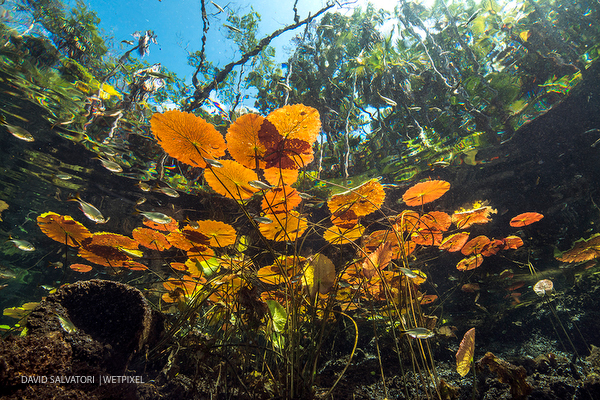
What are your “go-to” wide-angle exposure settings? How is your camera set up when you get off the boat?
Usually, a “go-to” is required when you are trying to approach a very elusive subject and you know you will have a very few opportunities for shooting it. In that case, I try to figure out the situation and I ask my local guides for more info about how the approach could typically occur. Based on the information received, my personal guess, and finally considering the ambient light and the water visibility, I get my settings. There’s no fix recipe, the experience makes the difference
When shooting large animals in the blue (green) do you worry about corner sharpness?
It’s a difficult trade-off, and my choice on my rectilinear wide-angle was made in a trip to Coco’s island where I shot sharks in very difficult conditions (low light, low viz) with three different lenses (16-35mm, 17-35mm, 14-24mm), and the key element to choose was actually the performance at the corners with open apertures. Now I am very happy with my 16-35 and performance at the corner are good.
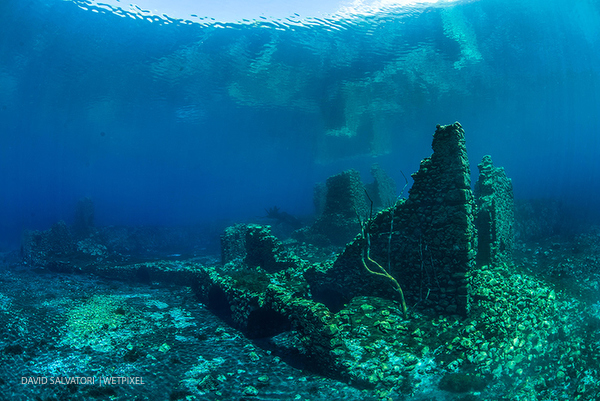
Under what situations would you use shutter priority or aperture priority wile shooting wide angle?
When shooting moving subjects in ambient light (w/o strobes).
David Fleetham
David Fleetham is one of the most published underwater photographers in the world. He began diving and photographing underwater in 1976 and his photograph of a sandbar shark appeared is the only underwater photograph to feature on the cover of LIFE.
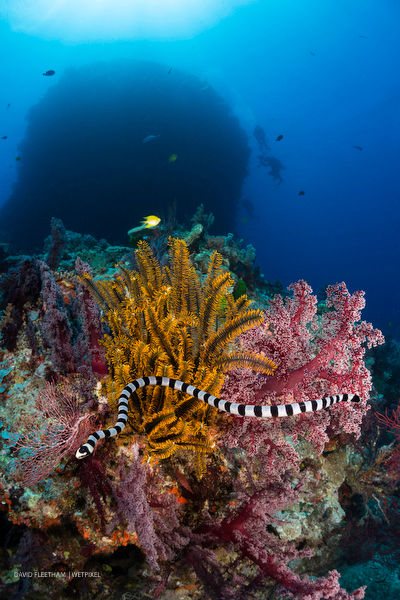
What is you favorite wide-angle lens (please also specify with which camera-more than one answer is allowed :))?
My Sigma 15mm full frame fisheye on my Canon 5D mark III.
Do you prefer the look of fisheye or rectilinear wide-angle?
I have shot a fisheye for 35 years. It started back in the film days with a Canon F-1 in British Columbia where visibility can be less than optimum. We called it “The Fog Cutter” up there. I shoot other rectilinear wide angle lenses, but I love the fisheye underwater.
How do you light wide-angle images or video? What metering pattern do you use? TTL or manual strobe control?
On my Canon 5D mark III I use the “Matrix Metering” and shoot 80% of my images with the TTL system in my Ikelite housing.
Do you “expose to the right”? Does this technique work/apply for video shooters?
No. I try to get the exposure to where it looks the best in the preview and histogram. This generally means turning the strobes back by a half stop on my Ikelite housing and a half stop to a full stop under with exposure compensation on my 5D.
What are your “go-to” wide-angle exposure settings? How is your camera set up when you get off the boat?
For wide angle I will jump in with ISO 320, f/11 on aperture priority and the compensation settings in my previous answer.
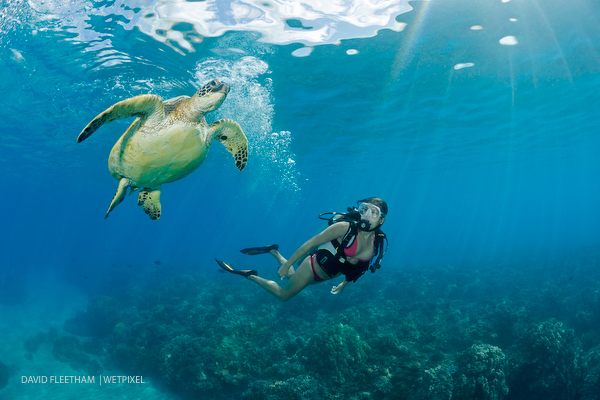
When shooting large animals in the blue (green) do you worry about corner sharpness?
Corner sharpness is alway in the back of my mind. I generally try to not open up beyond f/11 and will turn up my ISO before I open up any further.
Under what situations would you use shutter priority or aperture priority wile shooting wide angle?
I probably shoot half my wide angle on aperture priority and half of it on manual. It depends on the composition. If there is high percentage of blue water I will use aperture priority and under expose. If there is a high percentage of foreground reef in the composition I’ll switch over to manual.
Attached is an example of both. The vertical image was shot on manual and the horizontal on aperture priority.
Berkley White
Berkley owns Backscatter Underwater Photo and Video and his images and technical articles are published in US and international dive magazines. He regularly serves as a photographic judge or technical editor in publications.
What is you favorite wide-angle lens (please also specify with which camera-more than one answer is allowed :))?
The Tokina 10-17mm Fisheye is my long lost love, especially its sweet spot at 13mm on crop sensor cameras, small size, and low price. I now prefer full frame sensors for lower noise at high ISO’s which I’ve found essential for video. My current primary camera is a Canon 1DC which shoots full frame 18MP photos and 1.3x crop 4K video. I’ve found the Canon 8-15mm to be the sharpest and most versatile option for the 1DC and its crop changes when switching from photo to video. I always have a Sigma 15mm with Kenko Pro 1.4x Teleconverter and Canon 16-35mm packed as well, but they infrequently make it out of my bag.
Do you prefer the look of fisheye or rectilinear wide-angle?
This is certainly a hot topic with our professional clients. Might be a boxers vs briefs type argument. Ultimately as underwater shooters rectilinear vs fisheye lenses is a compromise between shooting distance vs distortion control. A rectilinear lens maintains straight edges, but requires you to shoot through much more water to get a similar shot as a fisheye. A rectilinear lens is less distorted for land based shooters, but underwater it’s much less forgiving in both focus and color. The closer working distance of a fisheye lens will always render sharper and more colorful underwater images. As a cameraman, I recommend clients to learn how to position a fisheye lens to get closer for better color and manage the attitude of the camera to minimize distortion. I only switch to a 16-35mm rectilinear type zoom lens if my subject will not let me get within 4-5 feet. Also, the difference in look is very pronounced during a video pan. Underwater, I prefer the curving edge look of a fisheye pan rather than the stretching edge look of a super wide rectilinear pan. Boxers vs. briefs.
How do you light wide-angle images or video? What metering pattern do you use? TTL or manual strobe control?
For the large majority of my stills I use dual Sea & Sea YS-250 strobes in manual mode, manual camera exposure, and a combination of spot metering mode and RGB histogram feedback to dial in a exposure. I change this up when shooting fast action. For monkeycam machine-gunning without strobes, I typically use shutter priority at 1/250 in matrix metering. If the shoot requires machine gun with strobes, I switch over to aperture priority with a default of f8 in matrix metering and dial in the strobes manually. I find even the best TTL strobe systems to be too slow for the frame rates I prefer to run on moving subjects.
Shooting video is an entirely different mindset for me. I calm the heck down and concentrate on steady camera work, white balance, focus, and run all exposure manually. I tend to have either Gates VL-24 lights or Keldan 8000 lights attached at all times. Even when lights are unnecessary, I find the added bulk of lights to help me keep my camera steady in video.
Do you “expose to the right”? Does this technique work/apply for video shooters?
Absolutely, I’ve been an evangelist for this photography technique for many years. DSLR cameras shoot compressed video and unlike raw photos require a more precise control on exposure and white balance in camera. DSLR video must be shot on the money to prevent banding or blowout in post. However, a professional raw video camera is designed to be flat on capture and needs to be exposed to balance highlights and blacks. If you’re shooting a DSLR, it’s always better to error towards a bright exposure in both photo and video.
What are your “go-to” wide-angle exposure settings? How is your camera set up when you get off the boat?
My dear friend Ernie Brooks first taught me… “F8 and be there.” Now we have ISO on demand without swapping film and chemical burn times. My digital jump settings for photo are F8, 1/125, ISO 200-400 with strobes set in manual at -1 stops. The first dial I move on my housing in water is ISO to match ambient light. Next is shutterspeed to dial in the blue.
When shooting large animals in the blue (green) do you worry about corner sharpness?
Only when shooting big schools of jacks or surprise corner subjects like pilot fish on a sharks nose. I try to never slip below f8 and maintain f11-16 for best corner sharpness… if I keep my head clear.
Under what situations would you use shutter priority or aperture priority wile shooting wide angle?
I touched on this topic above. I prefer manual exposure and I typically scout out three shooting zones (shooting angles) on each dive. For example, I first position myself with the sun at my back and try to set-up up three most likely exposure zones for most likely animal encounters. When a scene gets unpredictable, I switch to the above mentioned auto camera modes, but prefer to keep the strobes on manual to maximize frame rate.
Allison Vitsky Sallmon and Andy Sallmon
Andy and Allison Sallmon are professional marine photographers based in San Diego, California.
What is you favorite wide-angle lens (please also specify with which camera-more than one answer is allowed :))?
Our current favorite wide-angle setups are Canon 8-15 mm fisheye lens on full-frame Canon bodies (currently 5DMkIII’s). Other lenses we use include the Canon 16-35 mm lens and the Canon 14 mm lens, also both on full frame Canon bodies.
Do you prefer the look of fisheye or rectilinear wide-angle?
Fisheye or rectilinear – it depends on the subject. For most natural reefscapes, though, we prefer fisheye.
How do you light wide-angle images or video? What metering pattern do you use? TTL or manual strobe control?
We both use dual Sea and Sea YS250 strobes in manual, with center-weighted metering.
Do you “expose to the right”? Does this technique work/apply for video shooters?
Andy: exposes slightly to the right; Allison: no, although I generally try to bracket when I have a great subject.
What are your “go-to” wide-angle exposure settings? How is your camera set up when you get off the boat?
Our go-to settings: we have to answer your question with several questions of our own ;). Are we in green water or in clear water? What time of day is it? How deep is the dive? Are we anticipating stationary subjects or fast-moving ones? You get the idea - it depends on the individual dive. When headed to a local shipwreck at a depth of 40 meters on an dark, overcast morning in murky water, we might have initial settings of F7.1 at 1/30th and ISO320. Shooting mako sharks on a sunny afternoon in clear, shallow water, on the other hand, would prompt settings more along the lines of F11 at 1/200th and ISO160.
When shooting large animals in the blue (green) do you worry about corner sharpness?
Are we concerned about corner sharpness when shooting big animals in the blue: in general, no.
Under what situations would you use shutter priority or aperture priority wile shooting wide angle?
We have used shutter priority very rarely. One scenario: shooting without strobes when freediving (even then, we generally try to use manual settings). Neither of us has ever used aperture priority.
*Bonus tip: Photographers tend to run out and buy the latest, greatest miracle gizmo, overlooking the fact that proper technique trumps gadgetry 99% of the time. Perhaps the most important advice we can give about learning to shoot wide angle (or any) images underwater: take a class with a photographer whose work you admire, and then practice, practice, practice.
Norbert Wu
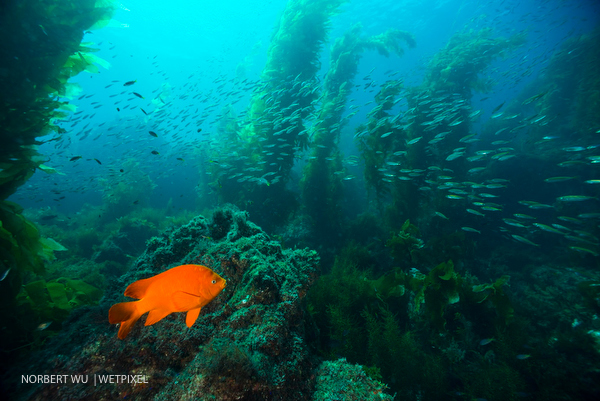
Norbert Wu was named “Outstanding Photographer of the Year” in 2004 by the North American Nature Photographers Association (NANPA).
What is you favorite wide-angle lens (please also specify with which camera-more than one answer is allowed :))?
I’ve had many favorite wide-angle lenses in the past 30 years of shooting. Until the advent of digital cameras, I and just about every other serious underwater photographer shot a huge amount with the Nikonos amphibious cameras and the UW-Nikkor 15mm lens. These lenses were corrected for underwater shooting, had an angle of 90 degrees, and were impressively sharp. They were such good underwater lenses that innovative housing manufacturers are still thinking of ways to use them today. The Nikonos with a 15mm lens was the perfect combination to shoot large, fast-moving subjects such as sharks and gamefish. I attach an image of a sailfish that I shot back then, on a medium known as “35mm film”, also known as a “transparency” or “slide.”
In the film days, I also shot a great deal with the Nikon 16mm fisheye lens in a housed system. It was super-wide, sharp, and very importantly could focus on subjects right up to the dome of the lens.
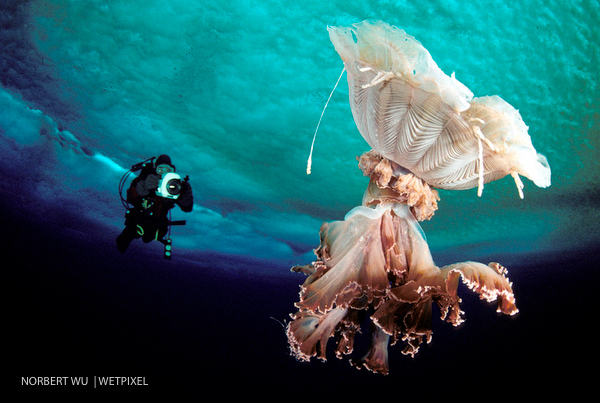
When digital cameras came out, I started using – and still like – the zoom range of the Tokina 10-17mm fisheye lens, made for APS-C sensors. It was the perfect wide-angle lens for underwater in a lot of ways. I used this lens with the Canon 7D camera and also my Nikon D7000 (no longer using underwater). I started out as a Canon shooter in the film days, so I still have a full complement of Canon lenses in my photo gear storage area. Somewhere in there, I had to sell all my Canon FD lenses so it’s been a long and sometimes expensive journey shooting Canon along with Nikon.
Ryan Canon of Reef Photo turned me on to the old Sigma 14mm f3.5 rectilinear lens a couple of years ago. (I have found Ryan’s knowledge of underwater photography and his recommendations to be encyclopedic and always right-on). Paired with the large (and heavy) Nauticam glass dome, it takes spectacular, sharp wide-angle images. I attach a couple of images that I shot with this lens (using an older Sea & Sea acrylic dome) with a Nikon D800 in a Nauticam housing last fall. It’s my favorite wide lens these days.
This lens has been discontinued for a long time and from what Ryan tells me, the replacement Sigma 14mm f2.8 lens is not as sharp. I remember my old friend Jim Watt (RIP) showing me this lens perhaps 15 years ago and raving about it. Jim was always excited about everything, so I didn’t take him seriously at the time. I’ve grown to really miss and appreciate Jim’s enthusiasm more and more as the years go by. It was only after Ryan suggested it that I got serious and bought one on eBay. I am pretty impressed with the lens. I discovered that this lens wouldn’t work with Canon digital cameras, however. Here’s something from the web about this: “This lens will only shoot wide-open with digital cameras. it would need re-chipped (sic) to function with digitals, and re-chipping is likely not an option.” So score one for going with the Nikon D800 rather than the Canon equivalent for once.
Do you prefer the look of fisheye or rectilinear wide-angle?
I shot a huge amount of fisheye during the film days. I attach a couple of my wide-angle shots from Antarctica, which were shot with a fisheye lens. It’s a great lens. The sharpness is great as is the color saturation. I have gotten a bit tired of the fisheye distortion, however. For some reason, this lens was perfect for the clear water and wide Antarctic underwater landscapes. But for kelp forests, where I still shoot a lot, the fisheye distortion is problematic and bothersome.
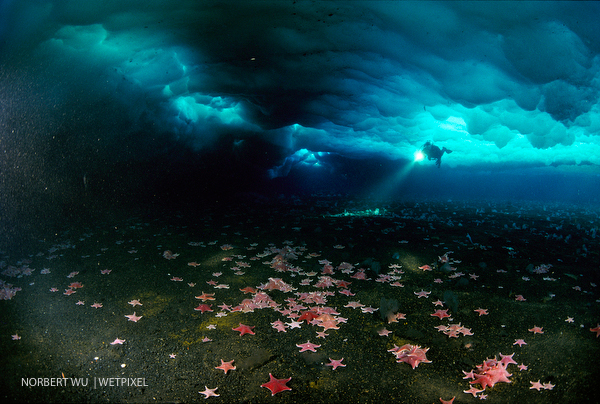
Both of the Antarctic images show the incredible sharpness and close-focusing ability of the Nikon 16mm fisheye.
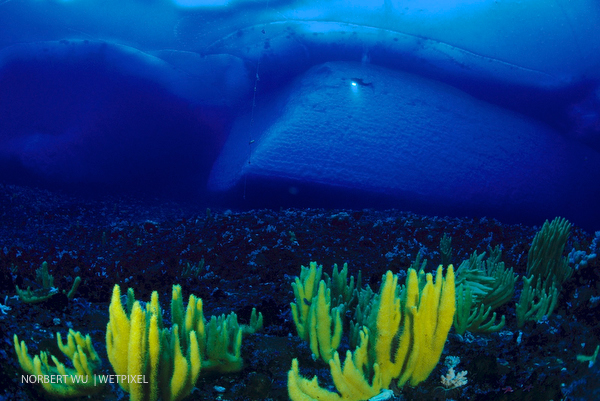
I have just started shooting 4K video with a Panasonic GH4 Micro-Four-Thirds camera and Nauticam housing. I’m excited about taking it to Socorro with me in less than a week. The 7-14mm and 8mm fisheye lens for this camera cover all the wide-angle shooting I’ll need. The Zen glass domes for these lenses are compact and I am sure will be super sharp as always.
How do you light wide-angle images or video? What metering pattern do you use? TTL or manual strobe control?
Before I talk about metering wide-angle images, I’d like to talk about how difficult it was to shoot wide-angle well in film days. Shooting macro has always been relatively easy, in a technical sense. Even in film days, after a while, experienced underwater photographers worked enough with their gear to be able to predict what aperture and flash setting they would need to get a properly exposed image. Most underwater flash units had about the same power underwater (the larger flash units had a wider beam angle but the same power at one foot away, for instance). So, with my Nikon 55mm macro lens and a fish at one foot away, I knew that my Oceanic 2001 flash unit placed above the housing would require an f11 to f8 aperture. Boom, done.
Backscatter is caused when your flash unit is placed in the wrong position and lights up particles in front of the subject rather than the subject itself. With macro shooting, there is so little water in front of the subject – and the angle of the flash is so extreme – that backscatter is rarely a problem. Not so with wide-angle shooting. With wide-angle shooting, the slightest misalignment of your flash units will result in horrible, unusable images – filled with backscatter or poorly lit. The subject has to be in the right position and your flash units have to be positioned near-perfectly. You will need to use TWO flash units, not one, to create images that show even lit scenes. With digital photography, the ability to shoot hundreds of images on a dive, and the instant feedback afforded by digital cameras, photographers today can create well-exposed wide images easily. If a flash is out of position – then the effect is easily seen and corrected.
This was not so in film days. In film days, being able to shoot artistic, properly exposed and composed wide-angle images separated the men from the boys – the pros from the amateurs. I think about the film days, and I am amazed that I was ever able to come back with anything worthwhile. Here’s a typical scenario. You load up a roll of Kodachrome 64 film in your Nikon F4. The power winder advances the film automatically to the first frame – number one. Here, the photographer has a decision to make. He’s charged up his strobes and connected them to the housing. Getting those strobes to fire underwater is ALWAYS a crapshoot. It’s a 50/50 chance that the strobes don’t work for some reason. However, this photographer has been careful and has kept his strobe connectors clean and his O-rings greased. He’s tested that the camera does indeed fire the strobes, firing the strobes when there was no film in the camera. However, the process of opening the housing and putting in the film cassette often shifts the electrical contacts inside and outside of the housing a bit, often enough to make the strobe fail once underwater. So it would behoove the careful photographer to test the strobe firing one last time after putting in the film and closing the housing. However, that would take a precious one frame out of the 36 frames available. Not being independently wealthy, the photographer decides that he’s been careful enough, and the system should work.
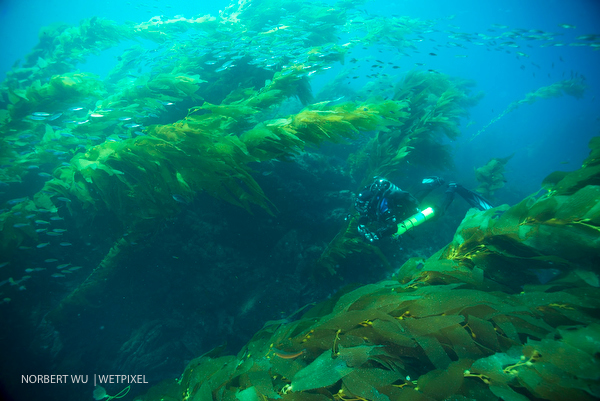
Perhaps an hour later (or in Antarctica, three hours later), the photographer finally is underwater. He has focused on his subject, a terrific wide scene. It has taken a long, bumpy boat ride (or in Antarctica, a long, bumpy Spryte ride over the ice) to get to his diving destination. The bumpy ride is no help to the electrical connections of the camera system or anything else. He has spent hours loading gear, putting on a drysuit, entering the water perhaps through an ice hole. He focuses the camera – the scene before him is beautiful. He presses the shutter release on his housing, and the camera clicks – but the strobes don’t fire! Argh! He has another one or two housings, perhaps, with him underwater for this project. Perhaps one of the housings does work in terms of firing strobe units when the shutter is depressed, but this is a camera set up for macro! Wash, rinse, and repeat the next day.
As I mentioned before my rant about the “good ole days”, it’s far easier these days to get wide-angle photography right. I use manual strobe control these days purely because I am forced to do so. I had a great Ikelite housing which let me control my Nikon D200 camera using TTL control – and it worked fabulously. I had a nice Light & Motion housing which let me control my strobes’ power output in ¼ stop increments by twirling a dial – and this worked fabulously also. These days, I have to somewhat laboriously twiddle the dials on my strobes, one at a time, which is slow and manual – but with digital photography, it’s easy to get the strobe settings where I want them. Having to change the power settings on my strobes manually, without L&M’s cool old ROC control or without TTL control, is laborious and not the best way, but it works OK for me.
Do you “expose to the right”? Does this technique work/apply for video shooters?
I don’t expose to the right, though I probably should. I always bracket my shots anyway, so I get a range of exposed shots of a subject. I spend too much time in front of a computer already and don’t want to spend more time tweaking images. I am also always concerned about going too far to the right and losing highlight detail in images. I certainly would not try this when shooting video. I could be wrong but it seems that the tools to correct over-exposure in video are not up to what you can do with still images.
What are your “go-to” wide-angle exposure settings? How is your camera set up when you get off the boat?
If you are shooting high-energy animals like sailfish or blue-water sharks, then you want to be sure that you have your camera set well before you jump in – or that you are prepared to make your settings quickly. Let’s say that you are lucky enough to have joined a trip to photograph the oceanic whitetip sharks in the Bahamas, with my friends (and awesome dive/shark operators there) at Epic Diving.
I will set the camera to shoot at 1/125th second, shutter priority, ISO 200 or 320. This way if something zooms up quickly in the blue water, I’ll likely get a correct exposure, and the subject will likely be sharp. The instant I get in the water, I’ll focus on my fins, which are about three to four feet away. I’ll then set my camera to manual focus. The lens is then set to a focus point of three feet, and with a wide-angle lens, everything from about 1-2 feet and infinity should be in focus. If a marlin dashes up closely, then the camera won’t sit there and hunt for focus on the marlin. The focus will be set and I can concentrate on framing this fast-moving animal. I’ll bracket all my exposures, perhaps set my shutter speed to 1/250th second to freeze fast-moving animals. I rarely shoot at faster shutter speeds underwater since animals don’t move that quickly, and faster shutter speeds might exceed the camera’s shutter sync speed.
Once I have time, I’ll probably set the camera to manual, and bracket my shots, with shutter speed fixed anywhere from 1/125th second to 1/60th second. I’ll bracket my shots using the aperture in 1/3-stop increments, up to a stop above and below what my camera’s light meter says. I probably should let the camera stay in shutter-priority these days and trust the auto-exposure more, but I tend to prefer manual settings because I am old school and like the control that manual settings give me.
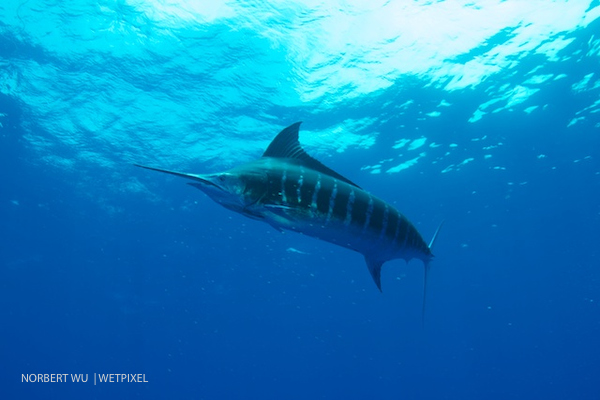
When shooting large animals in the blue (green) do you worry about corner sharpness?
Not at all. Corner sharpness is nice to have even in reef scenes, but if you look at successful underwater wide images, some of the best and most iconic images have poor corner sharpness. A great wide image should be so breathtaking that the viewer won’t notice a bit of corner fuzziness.
(Example image: blue marlin shot, Canon 7D, Tokina 10-17 lens, Nauticam housing): who cares about the corners in this shot?
Under what situations would you use shutter priority or aperture priority wile shooting wide angle?
I hardly ever use aperture-priority. I use shutter priority only when I first enter the water, in case I need to take shots quickly and immediately afeter entering. Once things have settled down and I have time, then I’ll go to manual exposure. An example would be a typical shark dive, where you enter the water and end up kneeling on the sand by a divemaster or shark handler. I’ll enter the water prepared to get some quick shots, but once I am situated on the bottom, I have a sense of my manual settings and work in manual from there.
- Amanda Cotton, Julian Cohen, Rico Besserdich, Jean Bruneau, David Barrio, Viktor Lyagushkin
- Cristian Dimitrius, David Salvatori, David Fleetham, Berkley White, Allison Vitsky Sallmon and Andy Sallmon, Norbert Wu
- Douglas Seifert, Daniel Botelho, Tony Wu, Franco Banfi, Steve Jones, Alex Tattersall